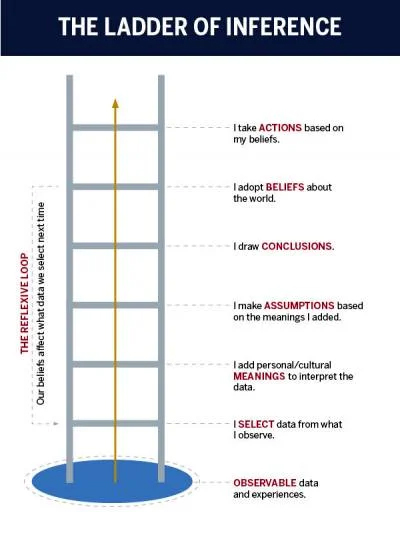On this page
Facilitating productive problem-solving meetings can be challenging. You want to foster an open dialogue and gain buy-in while working toward an ideal solution. To do this effectively, it helps to understand one very important aspect of human nature: how we reason.
A Tool for Better Group Reasoning
In my work with clients, I have found that the ladder of inference* is an essential framework for understanding human reasoning, identifying opportunities, and keeping group reasoning on track. It is especially helpful when your challenge involves ambiguity or complexity.
The ladder of inference lays out the mental steps in our reasoning — from receiving data to drawing a conclusion. It also explains how we adopt certain beliefs about the world.
While our reasoning process may feel logical, our analysis at every step is always based on past experience. And everyone’s experience is different.
Here is how the ladder of inference reveals our reasoning process:

- We begin with the pool of information available to us — the observable data and experiences.
- We then select some of the information — typically that which grabs our attention or seems particularly significant — and ignore the rest.
- Then, we interpret the information, drawing on personal/cultural meanings and making assumptions based on those meanings.
- Finally, we draw a conclusion based on that interpretation. Over time, these conclusions inform our beliefs and drive our actions.
Our beliefs might be founded on faulty selection or interpretation of data. For example, if you have a number of memorable interactions with a few customers, you might focus on and generalize from those experiences. This leads you to certain conclusions about the entire marketplace. We all proceed through these mental steps, often subconsciously. And we’re not always aware of our assumptions.
By using the ladder of inference as a tool to expose chains of reasoning, we are better able to understand ourselves and our colleagues, find the best solutions, and overcome resistance to change.
Your Role in Meetings of the Minds
As the moderator, your job is to:
- Listen carefully to the views expressed.
- Figure out what type of contribution each person is offering: belief, assumption, or interpretation.
- Bring hidden reasoning into the open by asking questions.
For example, if a person makes an assertion about what should be done, you might ask him or her to describe the chain of reasoning that led to that conclusion.
If two people have reached very different conclusions, one or both may be missing a key subset of data. Or perhaps they are missing an interpretive lens that would lead to a new set of possibilities.
The only way to know is to ask open-ended questions, such as:
- Can you help me understand your thinking?
- What was your chain of reasoning?
- What assumptions are you making?
- What data are you basing your recommendation on?
In asking these questions, you are not challenging people or judging them. You don’t want to put anyone on the defensive. Instead, you want to bring their reasoning to light so that it becomes part of the group’s thinking.
To do so, you can reflect back on what you’re hearing: “It sounds like we’re talking about assumptions here.” Or, if someone has difficulty articulating a chain of reasoning, you might say, “Think about it, and we’ll come back to you.”
At the same time, you should consider what is not being said. Keep in mind that silence does not imply agreement — or that a person has nothing to say. Your goal is to understand what’s happening in people’s heads and surface ideas that have not been articulated.
Better learning and decision-making result from staying low on the ladder. By slowing down the conversation — focusing on selecting and interpreting data — you encourage the group to avoid reaching conclusions prematurely. Using the ladder of inference, you can invite more contributions. Think about the ideas that might come to light when you ask questions like:
- Does anyone else have data that bears on this?
- Does anyone think something different might happen if we did this?
- Did anyone else arrive at a different conclusion?
- Did anyone make different assumptions?
The Ladder of Inference in Your Toolbox
As a manager, you can use the ladder of inference in multiple ways. You might start by employing it yourself as a framework for structuring your own thinking and interactions. Then, as you become more familiar with the approach, you can introduce the ladder as an explicit standard tool in team meetings.
Once you have introduced the concept, your team will begin to take on ownership of the process. They’ll develop better habits of mind and follow your lead by probing one another’s reasoning in meetings.
Over time, the ladder can become an integral part of how you think and work. Along the way, you’ll be encouraging open-mindedness, building more effective teams—and coming up with better solutions.
*The ladder of inference was initially developed by the late Chris Argyris, former professor at Harvard Business School, and elaborated on in numerous publications including The Fifth Discipline Fieldbook: Strategies and Tools for Building a Learning Organization (Peter Senge, Richard Ross, Bryan Smith, Charlotte Roberts, Art Kleiner).

